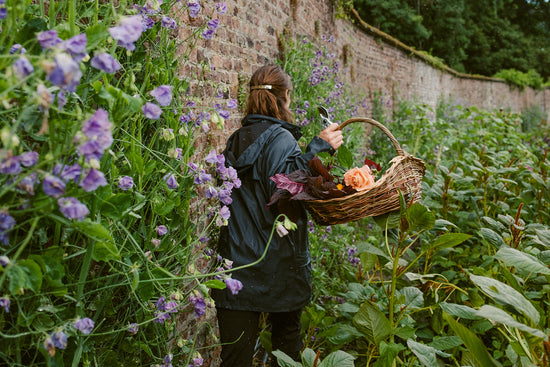Irish Times garden writer and flower farmer Fionnuala Fallon and her husband Richard Johnston established The Irish Flower Farmer in 2015 | This year Killruddery Cut Flowers + The Irish Flower Farmer are officially joining forces and sharing space in our restored Victorian walled garden to supply a wonderful range of seasonal, planet-friendly flowers.
In this important year of our development Fionnuala has agreed to contribute monthly to this blog; you can expect to hear observations on our progress in the garden and helpful tips on growing your own cut-flowers. Excuse us if from time to time we burst at the seams and want to share with you pictures of how we arrange and present these beautiful, sustainably-grown, seasonal blooms!
All images contributed by the same Richard Johnston – Photographer.
Killruddery Cut Flowers – August
One of the brightest stars of the late summer-autumn garden, dahlias are a special love of mine with their surreally beautiful, flouncy, edible blooms which appear from July until the first frosts. A huge and versatile genus of plants native to Mexico, South America and Central America, many thousands of varieties are available to gardeners to grow but for cutting purposes I concentrate on tall, vigorous, floriferous, versatile varieties with long stems and a good vase-life that are also capable of withstanding Ireland’s often-damp summers.
Among my current favourites are cut-flower classics such as ‘Jowey Winnie’, a ‘ball’ variety whose large, smoky-pink double flowers add a rich and dreamy glow to a bouquet or floral arrangement. Its spiritual twin – the two combine beautifully together – is ‘Linda’s Baby’, another must-have dusty-pink flowered ball variety that we grow in the cut-flower border at Killruddery alongside the oh-so-lovely coral-coloured Dahlia ‘Burlesca’. These combine beautifully with fruity-coloured Dahlia ‘Purple Haze’, wine-red Dahlia ‘Darkarin’ and the wonderfully versatile and productive Dahlia ‘Wine-Eyed Jill’.
Although its giant, ruffled flowers are famously delicate with tissue-soft petals that can be bruised by just one heavy rainshower, we also grow that rock-star of the dahlia world, D. ‘Café au Lait’. Surely the most famous dahlia in the world, this dinner-plate variety’s blooms are the perfect mix of ivory, peaches, apricot and cream and are an essential for bridal work.
As anyone who grows dahlias will know all too well, one of the great frustrations and occasional joys of cultivating these frost-tender tuberous plants is the perennial challenge of reliably sourcing your preferred varieties. I’ve lost count of the times that I’ve lovingly potted-up the fleshy tubers of a newly purchased, much-longed for variety in spring and planted it outdoors in early summer only to discover when it finally blooms that it’s a charming (or sometimes not-so-charming) imposter entirely unsuitable for cutting.
Propagating your own dahlias from cuttings is an excellent way to get around this problem, allowing you to reliably, quickly and cheaply build up stock of choice cutting varieties. This spring I propagated many dozens of new dahlia plants this way from mother stock that I planted into raised beds in Killruddery’s pithouse in February. Those baby cuttings have quickly rooted and bulked up, allowing me to plant them out into the border this summer where they’re now beginning to flower.
To keep our dahlias happy, healthy and productive, we make sure to plant them into weed-free, fertile soil in full sun, adding some handfuls of slow-release organic fertiliser to the planting hole to ensure that these fast-growing plants are kept well-fed. Regular watering, careful staking, a good slug-protection and deadheading routine along with fortnightly foliar feeds of liquid seaweed will then keep them flowering up until the first harsh frosts.
Here in Killruddery, those killer frosts usually come in mid-November, the plants’ blackened foliage a sign that it’s time to cut the stems back down to ground level and lift the fleshy tubers for storing undercover in a shed over winter. Another alternative is to leave some of them in situ, but to mulch them against the winter cold with a protective blanket of well-rotted manure.
Unless carefully labelled, it’s at this point that our must-have varieties will so easily go incognito again, which is why you’ll inevitably find me in the border in October, indelible pen in hand, carefully tying not one but two labels to the base of each plant so that they won’t get lost. Yes, it’s a lot of work but these beautiful divas are absolutely worth it.
Killruddery Cut Flowers – June 2021
Along with sustainability, seasonality is at the very heart of what Killruddery Cut Flowers is all about, from the first precious bunches of anemones that bloom in the walled garden’s Victorian pithouse in spring, to our in-house florist Aiva Veinberga’s wonderful winter wreaths adorned with dried flowers, seedheads, grasses and twiggy branches. Part of the magic of growing cut flowers and foliage in this way is learning to accept that no growing year or growing season will ever be exactly the same, with fluctuating temperatures, variable rainfall and changing light levels all having a significant effect on when and for how long different species will bloom.
For example, last year’s unusually warm, sunny spring resulted in a dramatic acceleration in growth levels, while this year was very different with a late, cold, dark spring that really slowed down growth but kept our anemones and ranunculus (cool-season flowers that dislike too much heat) blooming in Kilruddery’s pithouse and polytunnels until early June. After flowering their socks off for months, these beautiful spring blooms are now making way for summer-flowering heat-lovers such as zinnias and celosia as well as other cut-flower summer crops such as ornamental carrot and ammi that we’ve found perform better when grown under cover, protected from pests and diseases.
This year’s late cool spring had also delayed but prolonged the blooming period of spring- and early summer-flowering perennials that we grow outdoors such as aquilegia, sweet rocket, geum, lupins, luzula and tellima. Now coming to an end, they’ll soon be followed by summer-blooming cut-flower perennials such as echinacea, rubeckia, verbascum, phlox, linaria, potentilla and sanguisorba.
Raising thousands of young seedlings and cuttings under cover in spring as we do every year in Killruddery’s pithouse also has a huge effect on seasonality, bringing baby plants on, so that they flower much more quickly than if sown outdoors. Transplanted outside over the last number of weeks into their final growing positions, these young transplants now fill the walled garden’s 120-metre-long sunny border, which will very soon start bursting into glorious summer bloom. We’ve included hundreds of giant sunflowers in shades of plum and lime-green strawflowers (because who doesn’t love sunflowers), papery strawflowers, limonium, craspedia and starry helipterum for drying, choice dahlias in fruity shades of apricot, peach, plum and raspberry, plume-flowered amaranthus in tones of biscuit, coral and plum, ghostly scabious, silver-blue eryngiums, fluffy grasses and dozens of intensely-perfumed sweet pea. We’ve also made room for cress, gaura, cosmos, malope, phlox, atriplex, feverfew, snapdragons and asters, all species that will provide a gloriously diverse choice of exquisite summer and autumn cut flowers and fillers in the months ahead. In this way we’ll continue to celebrate the rich diversity and constantly shifting beauty of the Irish growing year in a truly seasonal way.
Killruddery Cut Flowers – April
At this time of year Killruddery’s wonderful Victorian pithouse starts filling up with thousands of young seedlings sown over the previous weeks. Almost all of these are of choice cut-flower varieties (hardy annual, biennial, half-hardy annual and perennial species) that just aren’t available to buy as young plants from garden centres or nurseries. Or if they are, they’re very expensive, making it prohibitively costly to plant them in the kinds of generous swathes needed to supply our new cut-flower room at Killruddery Farm Shop with the bucket loads of gorgeous, seasonal cut-stems required for bouquets and arrangements. Growing them from seed ourselves is the perfect solution, allowing us to quickly propagate a wealth of lovely, productive, must-have cut-flower varieties, from the oh-so-fashionable strawflower (Helichrysum bracteatum) to dainty annual phlox (Phlox drummondii) on a really large scale and in a way that’s brilliantly cost-effective.
Despite the numerous benefits of raising plants in this way, many gardeners can feel daunted by the whole seed-sowing process. If this rings true for you, then I’m delighted to share some handy tips guaranteed to make it a whole lot easier.
First and foremost is to use a fresh, good-quality seed compost (here at Killruddery we use Klasmann’s organic seed compost, we also stock Westland seed compost at our Farm Shop) while just as important is to use good quality, fresh seed sourced from a reputable supplier.
To ensure good germination and protect those precious baby seedlings from cold spring temperatures, we sow almost all of our cut-flower seed under cover into clean 2-litre plastic pots filled with damp, fresh seed compost, sprinkling a shallow layer of fine-grade vermiculite onto the surface of the compost immediately before sowing. To avoid producing weak, spindly seedlings, we also make sure to space the seed evenly, thinly and to the depth recommended on the packet.
Bear in mind also that while seed of most cut-flower species likes to be covered in a shallow layer of compost and/or vermiculite, some kinds actually need light to germinate so should be surface-sown. Classic examples include foxgloves (Digitalis), snapdragons (Antirrhinum), rudbeckia and nicotiana. Conversely, others need complete darkness- examples include annual phlox (Phlox drummondii) and Chinese forget-me-nots (Cynoglossum) – so we cover these with upturned black plastic pots, while some prefer cooler temperatures (examples include larkspur, delphinium and bupleurum) so we leave these outdoors. If in doubt, a quick google search will do a lot to steer you in the right direction as regards any particular plant’s preferences.
After sowing, every pot is labelled and then covered with an upturned, clear plastic freezer-bag ‘lid’ sealed with an elastic band to provide the sort of conditions ideal for optimum germination. Rather than top-watering, we prefer to bottom-water these pots by placing them up to their waists in a basin of tepid water for a few hours to gently wick up moisture. Then (the exception being any species that need cooler temperatures for germination) we put them on a raised propagation bed in Killruddery’s bright, frost-free pithouse where a simple heated soil cable buried in a layer of sand provides the kind of gentle bottom-heat that really boosts germination rates. But you could equally use a small electric propagator or a bright windowsill indoors.
Depending on the species, germination typically takes anywhere from a few days to several weeks, so we check the pots regularly for obvious signs. Once we see it, we move the pots off the heat and remove the bags to encourage strong, healthy growth. After that, it’s a simple case of growing the seedlings on in a very bright, frost-free spot in Killruddery’s pithouse until they’re ready to individually prick out into cell trays/ modules (available from all good garden centres) , something that we do when they’ve produced their first set of ‘true leaves’. Kept well-watered and given a very diluted liquid seaweed feed every 7-10 days, they’ll be transplanted out into their final positions in the walled garden’s cut-flower border in late May.
Words: Fionnuala Fallon | Photographs: Richard Johnston








